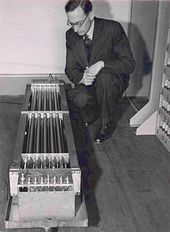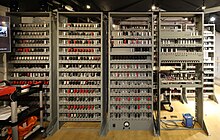EDSAC
[1] Inspired by John von Neumann's seminal First Draft of a Report on the EDVAC, the machine was constructed by Maurice Wilkes and his team at the University of Cambridge Mathematical Laboratory in England.In 1953, David Wheeler, returning from a stay at the University of Illinois, designed an index register as an extension to the original EDSAC hardware.John Lindley (diploma student 1958–1959) mentioned "the incredible difficulty we had ever to produce a single correct piece of paper tape with the crude and unreliable home-made punching, printing and verifying gear available in the late 50s".Unusually, the multiplier was designed to treat numbers as fixed-point fractions in the range −1 ≤ x < 1, i.e. the binary point was immediately to the right of the sign.[16][15] The machine was used by other members of the university to solve real problems, and many early techniques were developed that are now included in operating systems.[17] This is alluded to by Fred Hoyle in his novel The Black Cloud The early programmers had to make use of techniques frowned upon today—in particular, the use of self-modifying code.David Wheeler, who earned the world's first Computer Science PhD working on the project, is credited with inventing the concept of a subroutine.(However, Alan Turing discussed subroutines in a paper of 1945 on design proposals for the NPL ACE, going so far as to invent the concept of a return-address stack, which would have allowed recursion.This allowed quite complicated adjustments to be made to a general-purpose subroutine without making its final footprint in memory any larger than had it been tailored to a specific circumstance.[22] Ronald Fisher, in collaboration with Wilkes and Wheeler, used EDSAC to solve a differential equation relating to gene frequencies; this represented the first application of a computer to research in biology.The winners of three Nobel Prizes – John Kendrew and Max Perutz (Chemistry, 1962), Andrew Huxley (Medicine, 1963) and Martin Ryle (Physics, 1974) – benefitted from EDSAC's revolutionary computing power.In 1952, Sandy Douglas developed OXO, a version of noughts and crosses (tic-tac-toe) for the EDSAC, with graphical output to a VCR97 6" cathode-ray tube.[27][28] Another video game was created by Stanley Gill and involved a dot (termed a sheep) approaching a line in which one of two gates could be opened.In 1961, an EDSAC 2 version of Autocode, an ALGOL-like high-level programming language for scientists and engineers, was developed by David Hartley.





Maurice WilkesUniversity of Cambridge Mathematical LaboratoryUniversity of CambridgeOperating systemDeratedthermionic valvestemperature-stabilized mercury delay linesTeleprinterpunched tapeBackwardcompatibilityEDSAC 2John von NeumannFirst Draft of a Report on the EDVACstored-program computerManchester Mark 1J. Lyons & Co. Ltd.LEO Isquare numbersprime numbersEDSAC 2mercury delay linesvacuum tubesaccumulatorDavid WheelerUniversity of Illinoisindex registerdelay linelittle-endiantwo's complementbinarymultiplierfixed-pointsubroutinesuniselector switchesassemblerBeatrice Worsleycathode-ray tubeFred HoyleThe Black Cloudself-modifying codereturn addressWheeler Jumprecursive callsAlan Turingfloating-point arithmeticcomplex numbersexponentiationdifferential equationspower serieslogarithmsquadraturetrigonometric functionsrepeat until loopswhile loopsfor loopsvectorsmatricesassembly languageWhirlwindNat RochesterRonald Fisherbiologylargest knownJohn KendrewMax PerutzAndrew HuxleyMartin RylePeter Swinnerton-DyerBirch and Swinnerton-Dyer conjecturetop unsolved problems in mathematicsSandy Douglasnoughts and crossesfirst video gameStanley GillAutocodeDavid HartleyAtlas ComputerUniversity of ManchesterFerrantiPlesseyComputer Conservation SocietyNational Museum of ComputingBletchley ParkAndrew HerbertMargaret MarrsHistory of computing hardwareList of vacuum-tube computersWilkes, W. V.Manchester BabyWilliams tubeManchester Mark 1squaresintegersYouTubeUniversity of Cambridge Computer LaboratoryUniversity of WarwickFisher, R.A.About.comGreenwood Publishing GroupAddison–WesleyBirch, BryanSwinnerton-Dyer, PeterJ. Reine Angew. Math.Copeland, B. J.Turing, Alan M.Martin Campbell-KellyCharles Babbage InstituteILLIACORDVACIBM 701Douglas HartreePeter NaurAad van WijngardenFriedrich BauerLouis Couffignal